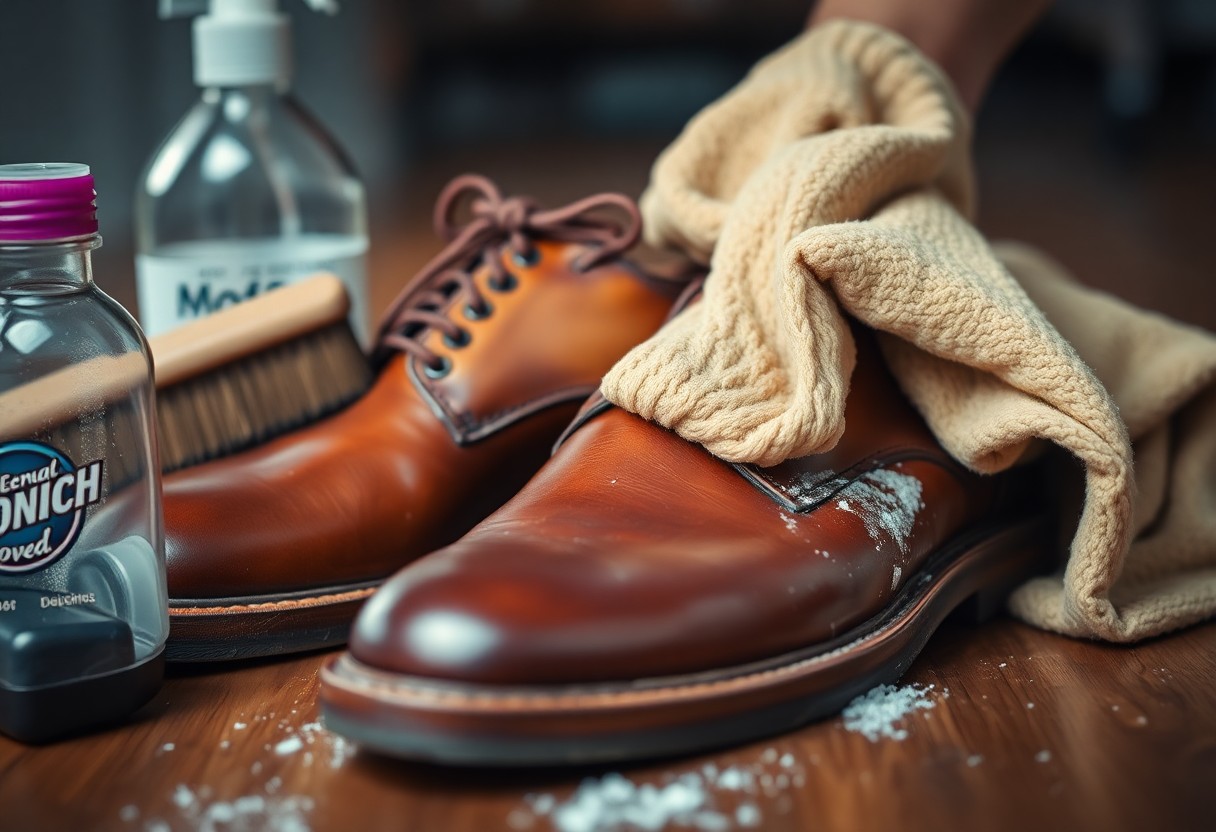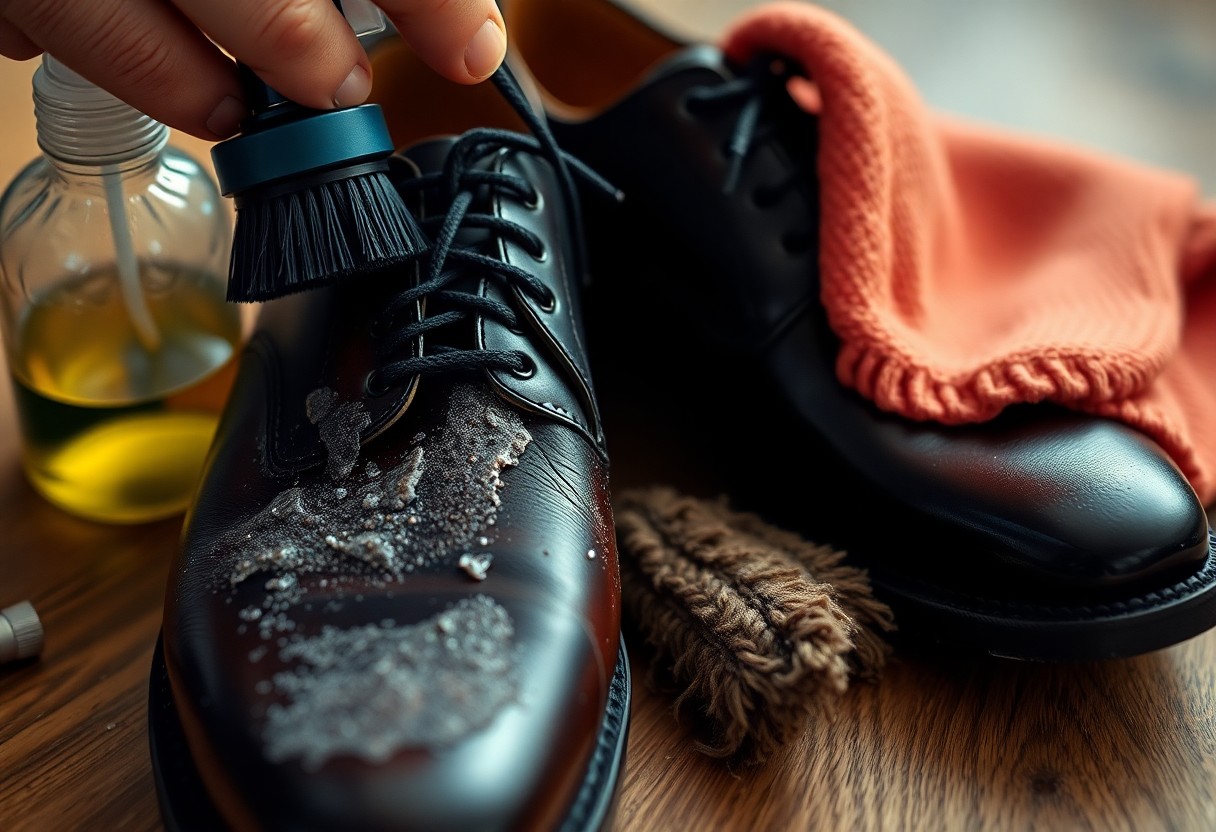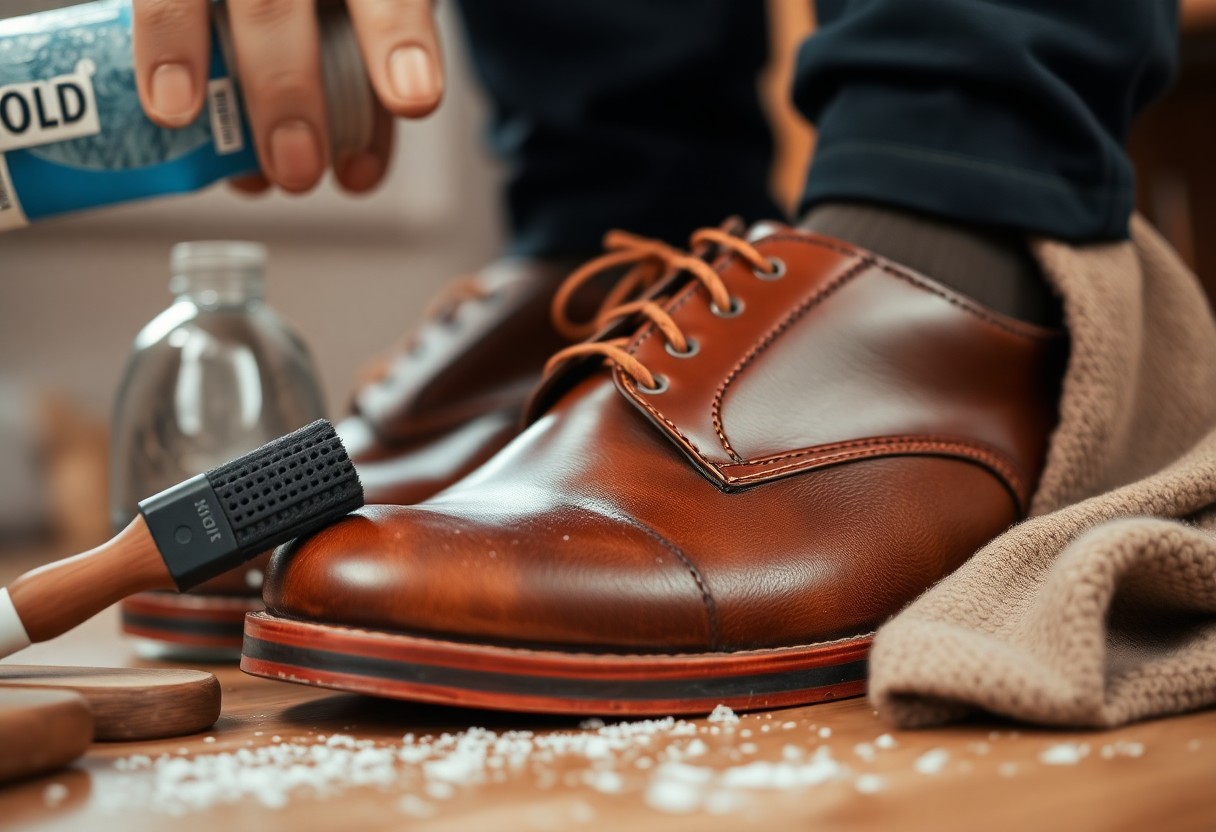This comprehensive guide will provide you with the essential knowledge and effective strategies needed to properly protect and restore your leather shoes from harmful mould growth. Recognizing the urgency of addressing mould is vital, as it can cause irreversible damage to your leather footwear if left untreated. Leather shoes are particularly vulnerable to mould in environments with high humidity and poor storage conditions. By implementing effective storage practices and maintaining regular maintenance routines, you can keep your leather shoes free from mould and enhance their longevity. This detailed guide covers proven techniques for both preventing mould formation and effectively removing it when necessary, ensuring your footwear stays in excellent condition.
Understand How Leather is Affected by Mould Growth
A deep understanding of how leather interacts with mould spores is critical for effective shoe care. Your leather shoes are constantly exposed to microscopic fungal spores present in the surrounding air. These spores can settle on the leather surface and proliferate under the right conditions, leading to significant damage to your cherished footwear. By comprehending the intricate relationship between leather and mould, you can implement preventive measures to enhance your shoes’ protection against mould infestation.
Recognize the Different Types of Mould That Can Affect Leather Shoes
Various types of mould can impact leather shoes, each presenting unique challenges for effective treatment:
- White mould – The most prevalent type, recognizable by its fuzzy patches on the surface.
- Green mould – Often found in damp environments and can be difficult to eradicate.
- Black mould – The most aggressive type, known for its persistent nature and potential health risks.
- Brown mould – Typically appears on untreated leather surfaces, causing discoloration.
Identifying the specific type of mould affecting your shoes is the first step in selecting the most effective treatment method to resolve the issue and protect your investment in quality footwear.
| Mould Type | Characteristics |
|---|---|
| White | Fuzzy patches, relatively easy to remove |
| Green | Commonly appears in high humidity and requires quick action |
| Black | Deeply infiltrates materials, making it the hardest to treat |
| Brown | Surface-level growth, moderate damage potential |
| Grey | Often found mixed with dust, exhibits moderate spread |
Identify Key Environmental Factors That Promote Mould Growth
Certain environmental conditions undoubtedly create ideal circumstances for mould to thrive on your shoes:
- Humidity levels exceeding 60% can foster mould development.
- Poor air circulation within storage areas contributes to moisture retention.
- Darkness combined with warmth creates a breeding ground for mould.
- Inadequate storage solutions exacerbate the problem.
This knowledge empowers you to devise improved storage solutions to safeguard your valuable footwear against mould growth.
Recognizing these environmental factors is essential for effective prevention:
- Temperature maintained between 77-86°F is ideal for shoe storage.
- Lack of adequate ventilation can lead to moisture accumulation in storage areas.
- Accumulation of moisture in storage areas can encourage mould growth.
- Extended storage in dark spaces without airflow increases the risk of mould.
This combination of factors creates optimal conditions for mould growth, necessitating careful consideration in your shoe storage practices.
Implement Effective Strategies to Prevent Mould Growth
To successfully shield your leather shoes from mould, you must adopt a combination of proactive measures. Focus on creating optimal storage conditions and maintaining consistent care routines to keep your footwear mould-free. Familiarizing yourself with these essential prevention techniques can save you from costly repairs and potential damage to your shoes over time.
Create Optimal Storage Conditions for Your Footwear
Achieving optimal shoe storage entails placing your footwear in well-ventilated areas where humidity levels remain consistently below 60%. Avoid closed-off spaces such as sealed closets or damp basements that can trap moisture and create a conducive environment for mould. Elevate your shoes on raised surfaces or shoe racks to promote air circulation, and consider using silica gel packets or cedar blocks to absorb excess moisture effectively. Implementing these practices will significantly reduce the risk of mould growth.
Engage in Regular Maintenance Practices to Extend Longevity
Even with the best storage solutions in place, it is crucial to complement them with a consistent care routine. Clean your shoes after each use, paying particular attention to removing dirt and moisture that can promote mould growth. Utilizing wooden shoe trees not only helps maintain the shape of your footwear but also absorbs moisture generated from daily wear. This simple addition to your shoe care routine can make a substantial difference in preventing mould.
Another vital aspect of maintenance involves applying a quality leather conditioner every 3-4 months, which helps keep the leather supple and resistant to mould growth. Regularly inspect your shoes for any signs of moisture or early mould development, which often manifests as small white or dark spots. Addressing these signs promptly can prevent larger issues in the future.

Follow a Structured Approach for Effective Mould Removal
To efficiently remove mould from your leather shoes, it’s essential to follow a systematic process that utilizes specific tools and methods to ensure safe and effective cleaning without risking damage to your footwear.
| Essential Items | Optional Items |
| – White vinegar – Cotton cloths – Protective gloves – Leather conditioner |
– Lemon juice – Shoe cream – Soft brush – Shoe trees |
Commence with an Initial Cleaning Process
Start by taking your mouldy shoes outside to prevent any spores from spreading indoors. Gently wipe away visible mould using a damp cloth soaked in warm water. Allow your shoes to air dry completely before proceeding to the next cleaning step to ensure the mould is not transferred back onto the leather during the cleaning process.
Utilize Effective Disinfection Methods
To thoroughly eliminate mould, create a solution of 12% vinegar. Apply this mixture evenly across your shoes with a clean cloth, ensuring that you cover all affected areas, including seams and stitching. A comprehensive disinfection process is crucial for preventing future mould growth and restoring the integrity of your leather. Treat both the exterior and the interior of your shoes, paying special attention to hidden areas where mould may develop. After treatment, allow your shoes to dry naturally in a well-ventilated area to ensure complete mould eradication.

Maintain Shoes in Optimal Condition After Mould Treatment
To keep your treated shoes in optimal condition, it’s important to monitor them regularly. After mould removal, check your shoes weekly for the first month to ensure that no mould returns. Store them in a well-ventilated area with humidity levels below 65% to prevent future mould growth. These proactive steps will help ensure your shoes remain in great shape.
Apply Leather Conditioning for Long-Lasting Protection
Regularly applying small amounts of leather conditioner can significantly extend the lifespan of your shoes. Use a high-quality leather conditioner every 3-4 months to maintain the leather’s natural moisture balance. This regular nourishment is essential for keeping your shoes flexible and resistant to future mould growth, enhancing their overall durability.
Adopt Protective Measures for Long-Term Care
For long-term protection, consider applying a water-repellent spray to your leather shoes every six months. This creates a protective barrier that prevents moisture from seeping into the leather while allowing it to breathe naturally. Additionally, placing silica gel packets or cedar blocks in your shoe storage area can aid in moisture absorption. These materials can decrease humidity levels by up to 40%, creating an environment where mould spores cannot thrive. Remember to replace these materials every 3-6 months for maximum effectiveness.
Essential Tools and Products for Mould Prevention and Removal
To effectively prevent and remove mould from your leather shoes, it is essential to have a well-organized toolkit comprising basic tools and products. This toolkit should include protective gear, cleaning solutions, and preventive items that will assist you in maintaining your footwear in optimal condition and preventing mould infestations.
Gather Essential Cleaning Materials
Key cleaning materials include 12% white vinegar solution, cotton cloths, soft brushes, and protective gloves. You’ll also require leather conditioner, shoe cream, and specialized leather cleaners. These materials are vital for safely removing mould without harming the leather surface of your shoes, ensuring a thorough yet gentle cleaning process.
Invest in Prevention Equipment for Effective Care
One of the most crucial aspects of leather shoe care is having the right prevention tools at your disposal. Your essential kit should include wooden shoe trees, silica gel packets, cedar shavings, and moisture-absorbing mats, all of which contribute to maintaining optimal air circulation and controlling humidity levels. These tools work synergistically to enhance your shoe care routine.
Cleaning and prevention equipment work hand in hand to protect your shoes from mould. If you reside in high-humidity areas, a dehumidifier can be an invaluable addition to your shoe care regimen. Ensure your storage space has adequate ventilation, and consider using perforated shoe boxes or open shoe racks to enhance airflow. Regular use of these tools can help you avoid up to 90% of common mould problems, keeping your footwear in pristine condition.

Avoid Common Mistakes in Leather Shoe Care to Prevent Mould
Effective leather shoe care requires specific attention to detail to prevent mould growth. The most common errors include improper drying techniques, the use of direct heat sources, and storing shoes in completely sealed spaces. By understanding these mistakes, you can better protect your leather shoes from mould damage and significantly extend their lifespan.
Recognize Storage Errors That Create Conditions for Mould Growth
Storing your shoes in dark, poorly ventilated areas creates ideal conditions for mould to thrive. Shoes require proper air circulation to prevent moisture accumulation. Keeping wet shoes in closed containers or placing them flat on surfaces without airflow can lead to severe mould issues, particularly on leather soles and seams.
Avoid Treatment Mistakes That Can Compromise Your Shoes
Mistakes made during the mould treatment process can lead to permanent damage to your leather shoes. The use of harsh chemicals, bleach, or incorrect cleaning techniques can compromise the leather’s natural properties and finish. It’s essential to avoid rushing the drying process or using excessive amounts of water during cleaning, as these actions can exacerbate mould growth.
Errors in treatment often occur when you skip crucial steps in the cleaning process. Using unsuitable products, neglecting to treat the entire shoe surface, or failing to condition the leather after cleaning can result in recurring mould problems. Your shoes require thorough care with appropriate cleaning agents like vinegar (12% solution), followed by conditioning to restore the leather’s protective properties and resilience.
Empower Yourself with Knowledge and Tools for Effective Shoe Care
Now that you possess all the necessary tools and knowledge to protect your leather shoes from mould and effectively address any existing mould issues, it’s time to implement these strategies. Your regular shoe care routine should encompass proper drying techniques, suitable storage with excellent air circulation, and the use of moisture absorbers. Should you discover mould on your shoes, you can handle it efficiently with a vinegar solution, followed by restoring the leather’s condition with proper conditioning afterward. These straightforward steps will empower you to keep your leather shoes in peak condition while preventing future mould complications.
Your Frequently Asked Questions Answered on Mould and Leather Shoes
Q: What preventative measures can I take to stop mould from forming on my leather shoes during storage?
A: To prevent mould, store shoes in a well-ventilated area that offers good air circulation. Avoid dark, humid spaces, and never store damp shoes in closed containers. Utilize wooden shoe trees, silica gel packets, or cedar shavings to absorb moisture effectively. Consider making ventilation holes in shoe boxes if you choose to use them for storage. Elevate shoes off flat surfaces using ribbed carpets or shoe racks to promote airflow underneath and reduce moisture retention.
Q: What is the most effective method for cleaning mould from leather shoes?
A: Begin by taking the shoes outside and gently wiping away surface mould with a damp cotton cloth soaked in hot water. Allow them to air dry completely before applying a 12% vinegar solution with a cloth or sponge to eradicate deeper mould. Ensure you cover the entire shoe surface to avoid unsightly water marks. Finally, allow the shoes to air dry thoroughly, then apply leather conditioner and shoe cream to restore moisture and protection to the leather.
Q: What steps should I follow if my leather shoes get wet to prevent mould growth?
A: Start by cleaning wet shoes with a damp cloth to remove any dirt. Dry them in a well-ventilated area at room temperature, avoiding direct heat sources that can warp the leather. Position shoes on their side or an uneven surface to improve air circulation and promote quicker drying. Avoid placing shoe trees in soaking wet shoes; instead, use newspaper to absorb excess moisture. Only insert wooden shoe trees once the shoes are partially dry. Replace wet newspaper as necessary until the shoes are completely dry to prevent mould growth.
The Article Preventing and removing mould from leather shoes tips and effective methods appeared first on My Shoes Finder
The Article Mould Prevention and Removal Tips for Leather Shoes Was Found On https://limitsofstrategy.com


One response
I really appreciate the depth you’ve provided in this guide about leather shoe care, particularly in relation to mould prevention and treatment. It’s fascinating how something as seemingly innocuous as humidity can greatly affect the lifespan of our cherished footwear. I’ve always been a bit of a shoe enthusiast, and I’ve learned the hard way how detrimental mould can be. A few years back, I neglected my favorite pair of leather boots during a particularly humid summer, and I was heartbroken to discover they were covered in mould. It was a tough lesson, but it encouraged me to delve deeper into proper shoe care and storage techniques.